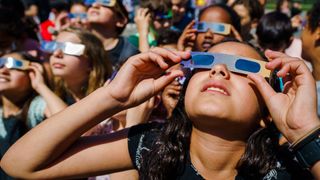Where to buy solar eclipse glasses before the Oct. 14 'ring of fire' eclipse
It's not too late to buy safe, high-quality eclipse glasses before the Oct. 14 annular solar eclipse in North America. Just make sure you're buying from an approved vendor.

On Oct. 14, a partial "ring of fire" solar eclipse will be visible across parts of North, Central and South America for the first time in more than a decade. With up to 90% of the sun's disk blocked by the moon depending on the viewer's location, this is a rare astronomical sight you won't want to miss — and one you definitely don't want to watch with your naked eyes.
Staring directly at the sun, even during a partial eclipse, can cause permanent eye damage, including blindness. According to NASA, the only safe way to watch an eclipse is through a pair of approved solar eclipse glasses or by viewing the eclipse indirectly with the help of a pinhole camera, kitchen colander or a well-placed disco ball.
Related: How to make a solar eclipse viewer to safely watch the 'ring of fire' eclipse on Oct. 14
If you want to go the eclipse-glasses route, it's not too late to order a pair before Saturday's event. The most important thing is to choose a pair that has been approved as safe by the American Astronomical Society (AAS), which tests and evaluates solar filters based on an international safety standard called ISO 12312-2.
You can view the AAS' list of approved eclipse glasses brands, including online vendors that resell those brands, on their official website, linked above. The list includes popular eclipse glasses manufacturers such as Lunt Solar Systems, American Paper Optics, Alpine Astronomical and many others that still have supplies in stock and offer express shipping.
You'll notice that the AAS doesn't share any links to Amazon, eBay or other online marketplaces. That's because, "in the weeks leading up to the August 2017 U.S. solar eclipse, such sites hosted numerous sellers of eclipse glasses and other solar viewers that had not been properly tested and shown to be safe," according to the AAS.
To avoid buying counterfeit or unsafe eclipse glasses when you're shopping through Amazon, make sure that the seller's name is identified on the site and that the same seller's name is one of the approved brands listed on the AAS page. A potential red flag to watch for is glasses marked as "NASA approved"; NASA does not approve any third-party products, so seeing this supposed selling point on an Amazon vendor's page can indicate the glasses are untested, according to the AAS.
If you're out of time and need to buy a pair of approved eclipse glasses in person, the AAS recommends stopping by a Home Depot, Lowe's or Walmart to check if they have any in stock. (Some, but not all, locations sell ISO-approved eclipse glasses, according to the AAS.) Additionally, many libraries around the U.S. will be giving away free pairs of approved eclipse glasses; call your local branch or check this site for a map of participating libraries.
One final, important note: Solar eclipse glasses are NOT the same as sunglasses. While sunglasses allow about 10% to 20% of daylight into your eyes, approved solar eclipse filters are typically 100,000 times darker, according to Live Science's sister site Space.com. Do not make the mistake of staring at the sun without the proper, safety-tested eyewear.
Live Science newsletter
Stay up to date on the latest science news by signing up for our Essentials newsletter.

Brandon is the space/physics editor at Live Science. His writing has appeared in The Washington Post, Reader's Digest, CBS.com, the Richard Dawkins Foundation website and other outlets. He holds a bachelor's degree in creative writing from the University of Arizona, with minors in journalism and media arts. He enjoys writing most about space, geoscience and the mysteries of the universe.
Most Popular

By Ben Turner

By Emily Cooke

By Ben Turner

By Ben Turner

By Robert Lea

By Sascha Pare

By Harry Baker